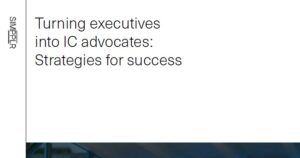4 ways to ensure your messaging resonates and sticks
Don’t be afraid of repetition, use vivid metaphors and illustrations, and prioritize candid feedback.

Envision the last time you presented new information to a group of employees in an extended session of one to three hours.
Were you:
- Rolling out new software and how they will access it to maintain their own file?
- Explaining a new or revised policy?
- Leading a training session?
As a communicator, you probably asked your audience several times during the presentation: “Do you understand?”
How do people generally respond? They nod, smile, say yes. Even if they don’t understand, they assume that they’ll figure it out later.
Some will. Some won’t.
Here are four ways to make sure that others really do understand what you’re communicating.
1. Don’t shy away from repetition.
If we learn anything from TV commercials, it’s that frequency pays. Some sponsors use the very same ad three to six times within a couple of hours. And on occasion, the commercial plays twice during the same network break — back to back!
Why?
The human brain filters out “noise.” Sometimes we have to hear a message six, seven, even eight times before it sticks. And consider this: Individual listeners are not always accepting “incoming” at the exact same time that you’re delivering “outgoing.” So don’t get frustrated with your group when you’ve “said it already.” Expect and plan to say it again. And again. And again.
Another reminder: Starting the repetitive answer with a phrase like, “As I mentioned earlier….” insults your listener. Paraphrased with “an attitude,” that phrasing means, “Weren’t you listening earlier, or are you just slow?”
2. Unpack your message in several ways.
Expand your meaning by elaborating. Here are some example lead-ins and transitions you might use to elaborate after you’ve overviewed your message:
- “Let me give you a situation where this would apply….”
- “You may be wondering what the implications of this change will be for you. Let me highlight some client complaints that we anticipate happening next quarter. First, ….”
- “Let me be clear about what we’re not expecting from you as you make the specific changes in your own departments.…”
- “What I’ve just said won’t apply equally to all departments. Here’s why some will see drastic changes and some divisions will not see any changes at all….”
You get the idea here.
3. Use metaphors, analogies and illustrations.
Like this one: “When we design the casing for the motor, we’re going to install a little device that operates much like a zipper. So if we need to do maintenance while it’s running, we can just unzip it without having to stop operations.”
Metaphors and analogies communicate big concepts in a few words.
For added impact and retention, toss in an anecdote or story. Can you get across your point about safety by recounting an incident in your organization where an employee was seriously injured and took months to recover because safety precautions were ignored? Can you emphasize the importance of cybersecurity by relating the story of how Leigh Ann lost $8,500 by clicking on a scam email link?
Stories, metaphors, analogies, acronyms, and other illustrations drive your point home.
4. Verify understanding by getting feedback.
I mentioned in my opening the ineffective question, “Do you understand?” (Unless you want off the hook for having to clarify!)
Instead, ask people questions to which their answers will demonstrate understanding. For example:
- “So how long do you think implementation will take?” If you had in mind a week and they say a couple of months, then you’ll know they are not understanding what you intend.
- What kind of budget will you need to complete such a project?” If you have in mind $1,000, and they anticipate $10,000, then you’ll know you need to talk further.
- “What kind of pushback do you anticipate we’ll hear from clients over the next couple of weeks?” Their “none” will communicate that they’ve missed your message about the negative impact of the new policy.
The point: Keep the ball in your court regarding who understands what. With their answers, you yourself can determine how well others understand what you’re communicating — and what you’re not communicating.
Before you end an important conversation or presentation, remember to repeat, unpack, illustrate, and verify as necessary. Do you understand? (Don’t worry; I’m not going to circle back.)
Dianna Booher is an author, executive coach and speaker. Read more of her ideas here.






